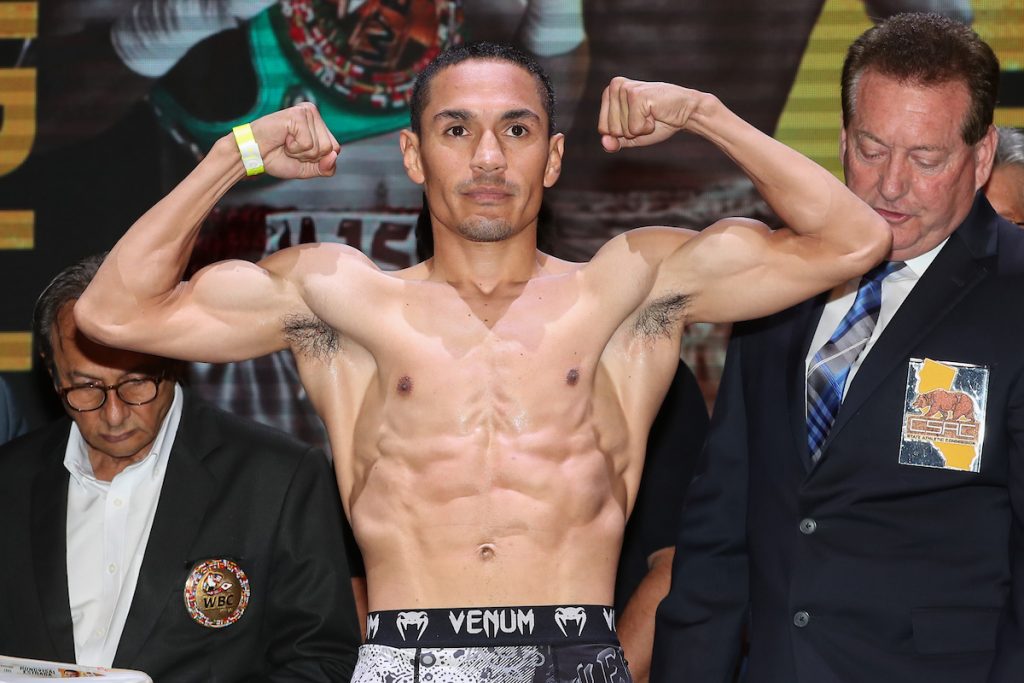Raw good: Estrada stops Beamon in Sonora

By Bart Barry-
Saturday in Hermosillo’s practically named Centro
de Usos Multiples, Sonora’s Juan Francisco “El Gallo” Estrada made a
harder-than-planned first defense of his Ring super flyweight championship
against North Carolina’s Dewayne “Mr. Stop Running” Beamon, on DAZN. Estrada dropped Beamon twice in round 2 and
punched him till no vim remained in round 9, and Panamanian referee Abdiel
Barragan interceded at the right moment.
Between rounds 2 and 9, though, Beamon gave Estrada a proper fitness
test.
Estrada is sensational in this way: If you might
employ a hybrid rating system, a blind sampling, that removes size and
ethnicity and purse and broadcaster hyperbole – raw raw, in lieu of rah rah –
he’d be top 5 on any list composed by an honest hand. He is distinguished by his losses, oldschool
style, much as his wins.
Since 2011 Estrada has lost twice. His first loss came to Chocolatito Gonzalez
in a fight that helped burnish Gonzalez’s ranking as the world’s best
prizefighter in any weight. Estrada’s
second loss came to the man who violently stamped the end of Chocolatito’s reign,
Srisaket Sor Rungvisai. The second loss
narrower than the first, and the first narrower
indeed than scorers had it. Estrada is
the only Mexican heir in his generation to the master Juan Manuel Marquez;
Estrada somehow fulfilled coach Nacho Beristain’s vision in Sonora, some 2,000
km north of Mexico City, whilst Beristain played celebrity slapntickle with Son
of the Legend and (ghost of) The Golden Boy.
Canelo Alvarez is, of course, Mexico prizefighting’s
greatest financial draw, but despite his admirable pursuit of able competition,
Canelo hasn’t Estrada’s class or mettle.
After losing to Chocolatito in a world title match at 108 pounds Estrada
fought Brian Viloria for a world title at 112 pounds, five months later, and
won a title Estrada defended five times.
Then Estrada got outworked by Sor Rungvisai, the man who put Chocolatito
in shavasana pose like a chocolate yogi – not outpunched or stiffened, mind
you, only outworked. And in April when
the rematch happened with Sor Rungvisai, Estrada went directly at one of our
sport’s hardest punchers and snatched his title.
All of that is a hell of a throatclearing preamble
to writing this: Estrada didn’t look great Saturday against an otherwise-anonymous,
34-year-old Carolinian named Dewayne Beamon (whom the Spanish-language
broadcast assured us gave up promising careers in both basketball [5-foot-5]
and football [114 1/2 pounds] to pursue boxing). Some of that was Estrada, but more of it was
Beamon.
Here’s the part that was Estrada. Making a first world-title defense in his
home state of Sonora since 2015 Estrada found himself subjected to all the
distracting ills of a homecoming – ticket requests, camp visits, interviews
with the local daily. Those distractions
told in Estrada’s conditioning. Estrada
would daze Beamon with a counter then unload on him with leads then spend a
bemused next round with his mouth open.
The oftener that pattern happened, the infrequenter Estrada soldout the
attack. Often as not after round 4
Estrada didn’t put it on Beamon until or unless Beamon pissed him off.
Beamon, frankly, was too savvy to do that very
often. If Estrada’s conditioning was
suspect Beamon’s was not. The Carolinian
trained for a world title challenge in the champ’s hometown and acted like
it. He absorbed very fine punches from a
very fine prizefighter and didn’t wilt till well offschedule. Class told eventually, but that eventuality
arrived later than aficionados expected and way way later than Estrada penciled
it in camp.
That tardiness was, in some part, a matter of
class. Estrada is a masterful
counterpuncher accustomed to landing apex predators on his fists. Which is to write the force of Beamon’s
attack wasn’t great enough to turn concussively against him – the same way a
hitter might drive an 80 mph fastball to the warning track with the same swing
he’d land a 100 mph fastball in the bleachers.
Beamon never really got the angle calculated for
his righthand. While we’re playing with
baseball metaphors, let’s go here: Beamon, accustomed to much lesser hitters,
didn’t hide the ball coming out of his windup.
However it looked on flatscreen, something Beamon did gave away his
righthand, and Estrada perceived it early every time. Sometimes Estrada went Mexican with that
perception and ate Beamon’s right glove to emasculate discourage the challenger
a bit. Most of the time Estrada let the
punch flash over him by the narrowest possible margin.
The two or three times Beamon threw the
telegraphed righthand and neither of the above scenarios played out, the two or
three times Beamon put a sting on Estrada, the champ retaliated swiftly and
disproportionately.
But here’s the thing about Beamon. He acquitted himself very well in his role of
designated homecoming opponent, giving Estrada far more than his paycheck
anticipated. Beamon was not going to
decision Estrada in Sonora and he wasn’t going to knock him stiff either, and
if the rest of us knew that during the ringwalk, Beamon surely knew it a
quarterhour before he succumbed. That
Beamon’s shoulders didn’t sag till round 9 speaks to Beamon’s character and
speaks of it well. “Mr. Stop Running” –
no, that nickname doesn’t work any more elegantly in Spanish – went in on the
champion, one of the world’s best prizefighters, and got his money’s worth. A good thing for Beamon, Estrada and the rest
of us.
Bart Barry can be reached via Twitter @bartbarry